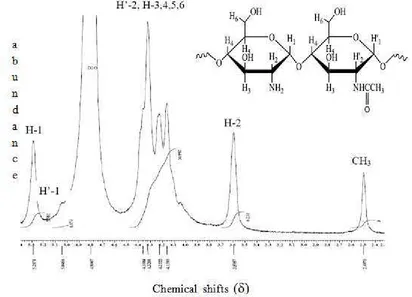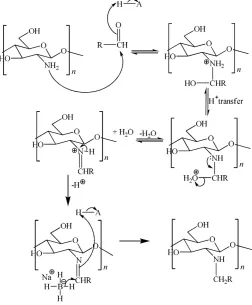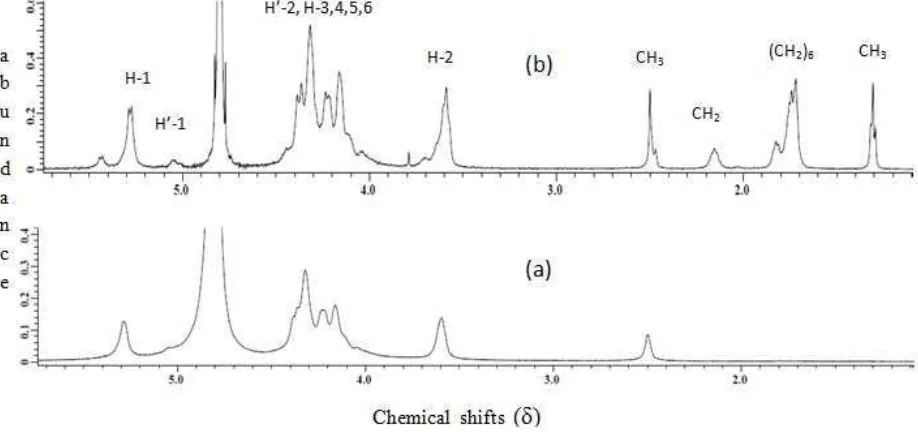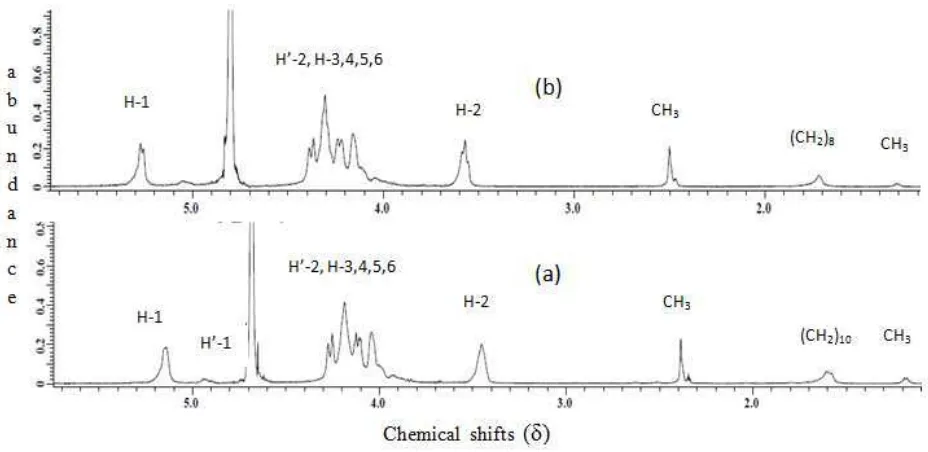Pelagia Research Library
Advances in Applied Science Research, 2015, 6(2):141-149
ISSN: 0976-8610
CODEN (USA): AASRFC
Synthesis and characterization of N-alkylchitosan as well as its potency as a
paper coating material
Hasna Tazkia Nikmawahda
1,
Purwantiningsih Sugita
2*and Budi Arifin
21Department of Chemistry Graduate Student, Bogor Agricultural University, Bogor, West Java, Indonesia 2Department of Chemistry, Bogor Agricultural University, Bogor, West Java, Indonesia
______________________________________________________________________________________________
ABSTRACT
N-Alkylchitosan is an amphiphilic chitosan’s derivative. Its alkyl side chain is hydrophobic and will reduce the water-absorption capacity of the hydrophilic chitosan. Therefore, it can be applied as waterproof paper coating in food packaging paper. In this study, N-alkylchitosan is synthesized from commercial chitosan having 86% deacetylation degree. Two synthetic methods were compared, in heterogenous system using suspended chitosan in methanol and homogenous system where chitosan was dissolved in 1% acetic acid at the first stage. The infrared spectra showed that synthesis conducted in homogenous system successfully synthesized N-octylchitosan. The degree of substitution (DS) value of the N-octylchitosan was 0.16, based on proton nuclear magnetic resonance analysis. Derivatives with longer alkyl side chain (N-decyl and N-dodecylchitosan) exhibited much lower DS, that is 0.02, which is predicted as the effect of increased steric hindrance. Therefore, based on this study, N-octylchitosan is the most potential as a waterproof paper coating because it has the highest value of DS.
Key words: chitosan, degree of substitution, N-octylchitosan, paper coating.
______________________________________________________________________________________________
INTRODUCTION
Paper is composed of cellulose fiber having a lot of hydroxyl functional group so it can absorb water from environment. This property will decrease its mechanical and physical strength, particularly in some application requiring paper properties as a barrier, as in food packaging paper. Therefore, to repair this property, paper is generally combined by varieties of coating material such as plastic or aluminium. Synthetic polymer such as polyethylene and polyamide, respectively can increase waterproof property and can decrease vapor transmission rate. Yet, commonly this synthetic polymer is difficult to be recycled and decomposed [1]. Renewable biopolymer-base coating is already developed nowadays since it is not toxic, easy to be decomposed and recycled.
Chitosan is a second biggest biopolymer in nature after cellulose and is obtained as deacetylation product of N -acetyl-D-glucosamine residue in chitin by using base [2]. Chitosan is not toxic, easy to be decomposed, biocompatible, and also has antibacterial property. Chitosan, because of its hydrophilic property, was used as coating and additive in paper making to increase resistivity to gas and oil [3]. Chitosan modification to N -alkylchitosan will give chitosan derivative which is amphiphilic since it has both hydrophilic and hydrophobic chain. The hydrophobic chain of N-alkylchitosan will decrease chitosan water-absorption capacity [4], so it can be used as waterproof coating in food packaging paper [5].
N-Alkylchitosan can be synthesized through reductive amination procedure. Primary amino group in chitosan form Schiff base with aldehyde and the secondary imine formed is reduced by sodium borohydride (NaBH4) [6, 7, 8, 9,
10, 11] or the other reducing agent such as sodium cyanoborohydride (NaBH3CN) [5,12], and potassium
borohydride (KBH4) [13, 14] to be N-alkylchitosan (Figure 1). Alkyl chain variation of N-alkylchitosan was tested
Octylchitosan having the highest DS value is the best to be used as paper coating among them since it has the lowest water-absorption capacity.
The higher DS value was reported by the other researcher. Mobarak and Abdullah [11] reported N-dodecylchitosan synthesis with DS value of 0.25. Rabea et al. [9] synthesized N-alkylchitosan from chitosan with deacetylation degree (DD) of 85% by using 3 kinds of aldehydes (butanal, octanal, and dodecanal) and gives products with DS, respectively 0.36, 0.22, and 0.10 for NH2:CHO mol ratio 1:0.3. Onesippe and Lagerge [15] synthesized N
-dodecylchitosan with DS 0.068 from chitosan having DD 75%. Liu et al. [14] synthesized N-octyl-O -metoxypolyethyleneglycol from chitosan having DD 95%, and DS of obtained N-octylchitosan is 0.543.
Figure 1. N-alkylchitosan synthesis reaction
In this research, commercial chitosan is synthesized to N-alkylchitosan through 2 methods. First method, synthesis was conducted in heterogeneous condition based on Liu et al. [14], while another is in homogeneous condition based on Rabea et al. [10]. The best method is chosen based on product recovery and synthesis success and applied to 3 aldehydes that is octanal (C-8), decanal (C-10), and dodecanal (C-12). Every N-alkylchitosan product DS value is analyzed to determine the most potential product to be applied as food packaging paper, which is product having the highest DS value. This research is aimed to determine the best synthesis method for N-alkylchitosan and also to determine alkyl chain length having highest potential to be applied as coating paper based on its DS value.
MATERIALS AND METHODS
Main material used is chitosan from PT Brataco Chemical and aldehydes (octanal, decanal, dodecanal) from PT Takasago Singapore. The instruments used were Fourier Transformation Infrared Spectrophotometer (FTIR) Perkin Elmer Spectrum One and proton nuclear magnetic resonance (1H NMR) JEOL 500 MHz.
Chitosan Characterization
In this research chitosan is characterized through water content, molecular weight, and deacetylation degree (DD) determination.
Water Content Determination [16]
Chitosan water content is determined by gravimetric method. Chitosan (±1.0000 g) is entered to crucible weighed before and then it is entered to oven (T= 105 °C ) for 3 hours. After that, it is entered to desiccator and weighed. Drying and weighing is replied until constant weight is obtained.
Chitosan Molecular Weight Determination [17]
Chitosan molecular weight is determined by viscometry method. Chitosan (±0.2500 g) is dissolved in acetic acid 0.5 M (250 mL). Then, from that parent solution, solution with varieties concentration 0.2, 0.4, 0.6, 0.8 and 1 g/L are made. Flow time of solution having lowest concentration to highest one (5 mL each) is determined by Ostwald viscometer (capillary tube diameter is 0.01 cm) respectively.
ln ηsp/c = [η] + k’[η] 2
_____________________________________________________________________________
Annotation: t = solution flow time t0 = solvent flow time
M = chitosan molecular weight
Chitosan Deacetylation Degree (DD) Determination
Chitosan is measured by 1H NMR spectrophotometer JEOL 500 MHz (T= 70 °C). Solvent used is CD3COOD/D2O
1%. DD value is determined based on first equation [15], second equation [18], and third equation [19]:
Annotation: lH-1 = H-1 peak area from glucosamine unit
lH’-1 = H’-1 peak area from N-acetylglucosamine unit
lCH3 = CH3 peak area from N-acetylglucosamine unit
DA = acetylation degree
N-Octylchitosan in Heterogeneous System [14]
Chitosan (± 5.0 g equivalent with 31 mmol) is suspended in methanol (60 mL) and stirred with magnetic stirrer in room temperature. Octanal (5.0 mL or 31 mmol) is added to that mixture and stirred with magnetic stirrer for 24 hours. Product formation is examined by TLC. NaBH4 reagent (2.5 g) is dissolved in water (10 mL) first and then
added to mixture drop by drop and stirred for 24 hours. Precipitate is then filtrated by vacuum filtration and filtrate obtained is neutralized by HCl. After that, precipitate is washed by methanol and water, dried in oven (T= 60 °C) for a night, and weighed.
N-Alkylchitosan in Homogeneous System [10]
Chitosan (± 0.5 g or 3 mmol) is dissolved in acetic acid 1% (v/v) solution (50 mL) while stirred for 2 days. 1 equivalent of aldehyde is added to that solution in room temperature, stirred for an hour, and its pH is adjusted to 4.5 by adding NaOH 1 M. NaBH4 (0.2 g) is dissolved in water (2 mL) and then added to that solution while stirred for
1.5 hours. In order to precipitate the product, pH of that solution is increased to 10. The formed precipitate is then washed and dried in oven (60 °C) for a night. The precipitate is then treated by Soxhlet with ethanol-diethyl ether (1:1) for 2 days, and dried in oven (60 °C) for 2 hours and weighed.
N-Alkylchitosan Degree of Substitution (DS) Determination
N-alkylchitosan is measured by 1H NMR spectrophotometer JEOL 500 MHz (T= 80 °C). The solvent used is CD3COOD/D2O 1%. DS value is calculated by equation (4) [20]:
Annotation: B = H-2 peak area from glucosamine unit
C = H’-2 peak area from N-acetylglucosamine and H-3,4,5,6 D = substituent peak area
n = hydrogen atom amount in substituent
RESULTS AND DISCUSSION
Chitosan Characteristics
DD value in this research is determined based on proton signals integration ratio in chitosan 1H NMR spectrum which is measured at 70 °C. Spectrum and interpretation of that signals is showed in Figure 2 and Table 1. Figure 2 explains that signal at 2.5 ppm is CH3 proton signal from N-acetylglucosamine unit, experiencing electron-attraction
from amide carbonyl group. While signal at 3.6 ppm is come from H-2 atom of glucosamine residue. This signal is more downfield since induction effect of electron-attraction that is stronger from amino group. Signals at 4.1−4.5 ppm is overlapping signals of H’-2 from N-acetylglucosamine residue and H-3,4,5,6. This signal is more downfield compared to H-2 of glucosamine residue since H’-2 atom experiences smaller electron-donation from amide N atom than obtained by H-2 atom from amine N atom. While H-3,4,5,6 atom experience stronger electron-attraction from O atom which is more electronegative than N atom. Signals at 5.05 and 5.3 ppm are H’-1 from N-acetylglucosamine and H-1 from glucosamine unit respectively. Both of them is more downfield since they experience direct electron-attraction from 2 O atoms in acetal group and indirect electron-electron-attraction from N atom [10, 18, 19].
Figure 2. Chitosan 1H NMR spectrum at 70 °C (500 MHz, CD3COOD/D2O 1%)
Table 1 explains integration from each protons observed from 1H NMR spectrum as data for chitosan DD calculation. The result is based on 3 equations stated by [15] (equation 1), [18] (equation 2), and [19] (equation 3) gives chitosan DD value of 85.63%, 85.99%, and 85.67%, respectively. Therefore, it can be concluded that chitosan used has DD of 86%. The perfect DD value (100%) is rarely obtained since chitosan generally still contains N -acetyl-D-glucosamine residue [21].
Table 1. Proton integration (I) observed from chitosan 1H NMR spectrum
Proton Chemical shift (ppm) Integration (I)
CH3 2.5 3.0000
H-2 3.6 6.2313
H’-2, H-3,4,5,6 4.1−4.5 30.8968
H’-1 5.05 0.9739
H-1 5.3 5.9813
N-Octylchitosan Synthesis Result in Heterogeneous and Homogeneous System
_____________________________________________________________________________
methanol, and reacted with octanal. Phase difference between chitosan and octanal is predicted to be the cause of alkylation reaction failure.
Deacetylation degree of chitosan raw material that is less than 90% is predicted to give big enough steric hindrance of –NHCOCH3 group (asetamido) so inhibit interaction between chitosan –NH2 group and octanal aldehyde (–CHO)
group in imine formation. Zhang et al. [13] and Liu et al. [14] reporting this heterogeneous synthesis success used chitosan with DD of 97% and 95%, respectively. Modification that can be done to increase the success of this alkylation is by dissolving chitosan in acetic acid first, then adding ethanol or methanol before aldehyde addition [12, 22, 23, 24]. This is aimed to make the mixture more homogeneous so the alkylation reaction can take place in that condition.
N-Octylchitosan is then synthesized in homogeneous system by Rabea et al. [10 method. Chitosan is dissolved in acetic acid 1% (v/v) so the active sites is enlarged and makes the reaction with octanal to be imine easier. The pH control is needed in imine formation. Acid will protonate carbonyl group so C-carbonyl atom become more electrophilic to NH2 attack. Therefore, imine is generally formed faster at pH between 4 and 5 [25]. Desbrières et al.
[12] stated that reaction can last at pH 4−8, while Rinaudo [2] adjusted optimum pH of imine formation reaction at pH 5.05−5.10. Imine formation reaction will take place slower if pH is too low or too high [25]. It can be explained from reaction mechanism showed in Figure 3.
Figure 3. Reductive amination reaction mechanism in chitosan
In the too acid condition, NH2 will be protonated to NH3 +
so its nucleophilicity to add aldehyde in initial reaction is lost. Otherwise, if pH is too base,–OH group is hard to be protonated to be –OH2+ so water elimination to form
iminium ion in the next stage does not take place. After the imine was formed, C=N double bond is reduced by NaBH4 and N-octylchitosan, the product, is formed. This product is a yellow hard lump with the lighter color that the
initial chitosan. Its reaction recovery is 48%.
N-alkylchitosan Characteristics
with raw chitosan spectrum. Therefore, method used to synthesize the other N-alkylchitosan derivative, which is N -decyl and N-dodecyl chitosan is synthesis method in homogeneous system.
Table 2. The FTIR spectrum analysis result of raw material and chitosan alkylation product
Functional group
Wavenumber (cm-1) N-octylchitosan
Chitosan Octanal Heterogeneous system Homogeneous system
OH and NH2 stretch 3462, 3445 3484, 3446 3504, 3464 -
Aliphatic CH stretch 2857 2868 2891 2859
-NH-CH2- - 1540 - -
CO stretch 1663 1649 1648 1725
Amide III band 1375 1395 1375 -
The other identification to prove that the alkylation took place at N atom in glucosamine (chitosan) is conducted by
1
H NMR characterization and data obtained can be used to calculate DS value at once. The 1H NMR spectrum of N -alkylchitosan and chitosan are showed in Figure 4. The 1H NMR signals interpretation of chitosan compound (Figure 4a) and N-octylchitosan (Figure 4b) is extinguished by absorption from N-octyl (-NH-CH2-(CH2)6-CH3)
group giving 3 signals at 1.4, 1.8, and 2.2 ppm that is only appear for N-octylchitosan. Signal at 1.4 ppm is predicted come from -CH3 proton, while signal at 2.2 ppm is given from methylene proton experiencing direct
electron-attraction from N atom. The other methylene protons overlap and form multiplet at 1.8 ppm. While at chitosan (Figure 4a), that chemical shift does not appear.
Figure 4 The 1H NMR spectrum at 70 °C: chitosan (a), N-octylchitosan (b)
The effect of Alkyl Chain Length Variation to Recovery and Degree of Substitution
N-Decyl and N-dodecylchitosan are also synthesized successfully in homogeneous system. Both of them are also characterized by 1H NMR. Their spectrum is showed in Figure 5. In Figure 5a and b shows that in chemical shift area from N-alkyl (-NH-CH2-(CH2)n-CH3) group, the signal intensity in aliphatic area is decreased compared to N
-octylchitosan (Figure 4b). It is predicted to be the cause of low amount of alkyl chain substituted at chitosan chain. Further interpretation from that 1H NMR data is used to calculate DS. Table 3 shows normalization data from NMR spectrum from the 3 compounds of N-alkylchitosan (Figure 4b, 5a and 5b) which is very useful to calculate DS value. DS value for every N-alkylkitosan is calculated based on equation 4.
_____________________________________________________________________________
Figure 5. The 1H NMR spectrum at 70 °C: N-decylchitosan (a), N-dodecylchitosan (b)
Table 3. Normalization value from every proton peaks in NMR spectrum
Annotation: δ = chemical shift
Degree of substitution value is decreased significantly from 0.16 in N-octylchitosan to 0.04 in N-nonylchitosan. It shows that the longest alkyl chain still giving high enough DS value is octanal. Nonanal until dodecanal will get difficulty to access chitosan chain since the alkyl chain is long. Increasing mol ratio of aldehyde and chitosan was reported to be able to increase DS value of N-alkylchitosan. Rabea et al. [9] stated that octanal and chitosan mol ratio are made 15 times of butanal and chitosan mol ratio will increase N-octylchitosan DS value to 0.90, higher than
N-buthylchitosan that is only 0.81. Rabea et al. [10] obtained N-octylchitosan DS value of 0.12 with mol ratio NH2:CHO (1:0.3), that is increased to 0.22 with mol ratio NH2:CHO (1:1). Therefore, DS value is still able to be
the recovery. N-decyl and N-dodecylchitosan recovery value are same and it influences their recovery which is relatively same.
Gambar 6 N-alkylchitosan DS value depression trend related to alkyl chain length rising: C-8, C-10, C-12 (this research result) compared to C-5, C-7, C-9, and C-11 [9]
Table 4. Data approach to determine N-alkylchitosan recovery based on DD and DS value
Sample Iteration Chitosan weight (g) N-alkylchitosan weight (g) Recovery (%)
N-Octylchitosan 1 0.5036 0.4119 73.33
N-Alkylchitosan synthesized in this research is expected to have a potency as paper coating to repair its waterproof property. Nicu et al. [4] reported that N-octylchitosan having highest DS value of 0.0374 has the lowest water-absorption capacity, that is 20 g/m2, make it the best to be applied as waterproof paper coating compared to N-decyl and N-dodecylchitosan having water-absorption capacity of 40 g/m2 with DS value of 0.0351 and 0.0334. In advance, Nicu et al. [4] stated that shorter alkyl chain with highest DS value can form a more compact and uniform film compared to the longer alkyl chain. This research successfully synthesizes N-octylchitosan with DS value of 0.16, 4 times higher than Nicu et al. [4] synthesis result so this product is expected to be used as a better waterproof paper coating.
CONCLUSION
N-alkylchitosan is successfully synthesized in homogeneous system with chitosan which is dissolved in acetic acid 1% first and is unsuccessful to be synthesized in heterogeneous system with chitosan which is only suspended in methanol. The highest DS value is obtained for N-octylchitosan of 0.16 and the same DS value for N-decylchitosan and N-dodecylchitosan of 0.02 is also obtained. Hence, N-octylchitosan is the most potential among the others as waterproof paper coating since it has the highest DS.
Acknowledgements
The authors wish to express appreciation to the Directorate General of Higher Education, the Ministry of Educational Culture for funding through research program granted to Prof. Dr. Purwantiningsih Sugita, MS
REFERENCES
[1] Kwaldia K, Tehrany EA, Desorby S. Comprehensive Rev Food Sci Food Safety. 2010. 9:82-91. [2] Rinaudo M, Auzely R, Vallin C, Mullagaliev I. Biomacromolecules. 2005. 6(5):2396-2407. [3] Kjellgren H, Gällstedt M, Engström G, Järnström L. Carbohydr Polym. 2006. 65:453-460. [4] Nicu R, Lupei M, Balan T, Bobu E.Cellulose Chem Technol.2013. 47(7-8):623-630.
[5] Bobu E, Nicu R, Lupei M, Ciolacu FL, Desbrières J. Cellulose Chem Technol.2011. 45(9-10):619-625.
[6] Muzzarelli RAA, Frega N, Miliani, Muzzarelli MC, Cartolari M. Carbohydr Polym. 2000. 43:263-268.
_____________________________________________________________________________
[7] Ramos VM, Rodriguez NM, Rodriguez MS, Heras A, Agullo E. Carbohydr Polym. 2003. 51:425-429.
[8] Avadi MR, Gholamreza M, Asal MS, Mohammad E, Mohsen A, Morteza RT, Abbas S. Iranian Polym J. 2004. 13(5):431-436.
[9] Rabea EI, Badawy MEI, Steurbaut W, Rogge TM, Stevens CV, Smagghe G, Hofte M. Comm Appl Biol Sci.
2005a. 70(3):219-223.
[10] Rabea EI, Mohamed EB, Tina MR, Christian VS, Monica H, Walter S, Guy S. Pest Management Sci. 2005b. 61:951-960.
[11] Mobarak NN, Abdullah MP. Malaysian J Anal Sci. 2010. 14(2):82-99. [12] Desbrières J, Martinez C, Rinaudo M. Int J Biol Macromol. 1996. 19:21-28. [13] Zhang C, Ping Q, Zhang H, Shen J. Carbohydr Polym. 2003. 54:137-141. [14] Liu G, Gan J, Chen A, Liu Q, Zhao X. J Nat Sci. 2010. 2(7):707-712. [15] Onesippe C, Lagerge S. Carbohydr Polym. 2008. 74:648-658.
[16] [AOAC]. Association of Official Analytical Chemist. Official Methods of AOAC International. 14th Ed. Arlington (US): AOAC. 2006.
[17] Tarbojevich M, J Cosani A. Molecular weight determination of chitin and chitosan. In: Muzarelli RAA, Peter MG, editor. Chitin Handbook. Ancona (IT): European Chitin Society. 1996. pp 85-108.
[18] Lavertu M, Xia Z, Sereqi AN, Berrada, Rodrigues A, Wang D, Buschmann MD, Gupta A. J Pharm Biomed Anal. 2003. 32:1149-1158.
[19] Renata CB, Jarosinska D, Rokita B, Ulanski P, Rosiak JM. Prog Chem Appl Chitin. 2012. 17:5-20.
[20] BadawyMEI, RabeaEI, RoggeTM, StevensCV, Smagghe G, SteurbautW, HofteM. Biomacromolecules. 2004. 5:589-595.
[21] Aranaz I, Harris R, Heras A. Curr Org Chem. 2010. 14(3):308-330.
[22] Klotzbach T, Watt M, Ansari Y, Minteer DS. J MembrSci. 2006. 282:276-283.
[23] Jiao TF, Zhou J, Zhou JX, Gao LH, Xing YY, Li XH. Iranian Polym J. 201120(2):123-136. [24] Wang X, Li D, Sun R. Polym Preprints.2011. 52 (2):221-222.
[25] Solomons TG, Fryhle CB. Organic Chemistry. Ed ke-10.New Jersey(US): J Wiley. 2011.





![Gambar 6 N-alkylchitosan DS value depression trend related to alkyl chain length rising: C-8, C-10, C-12 (this research result) compared to C-5, C-7, C-9, and C-11 [9]](https://thumb-ap.123doks.com/thumbv2/123dok/554985.433466/8.595.137.476.320.415/gambar-alkylchitosan-depression-related-length-research-result-compared.webp)